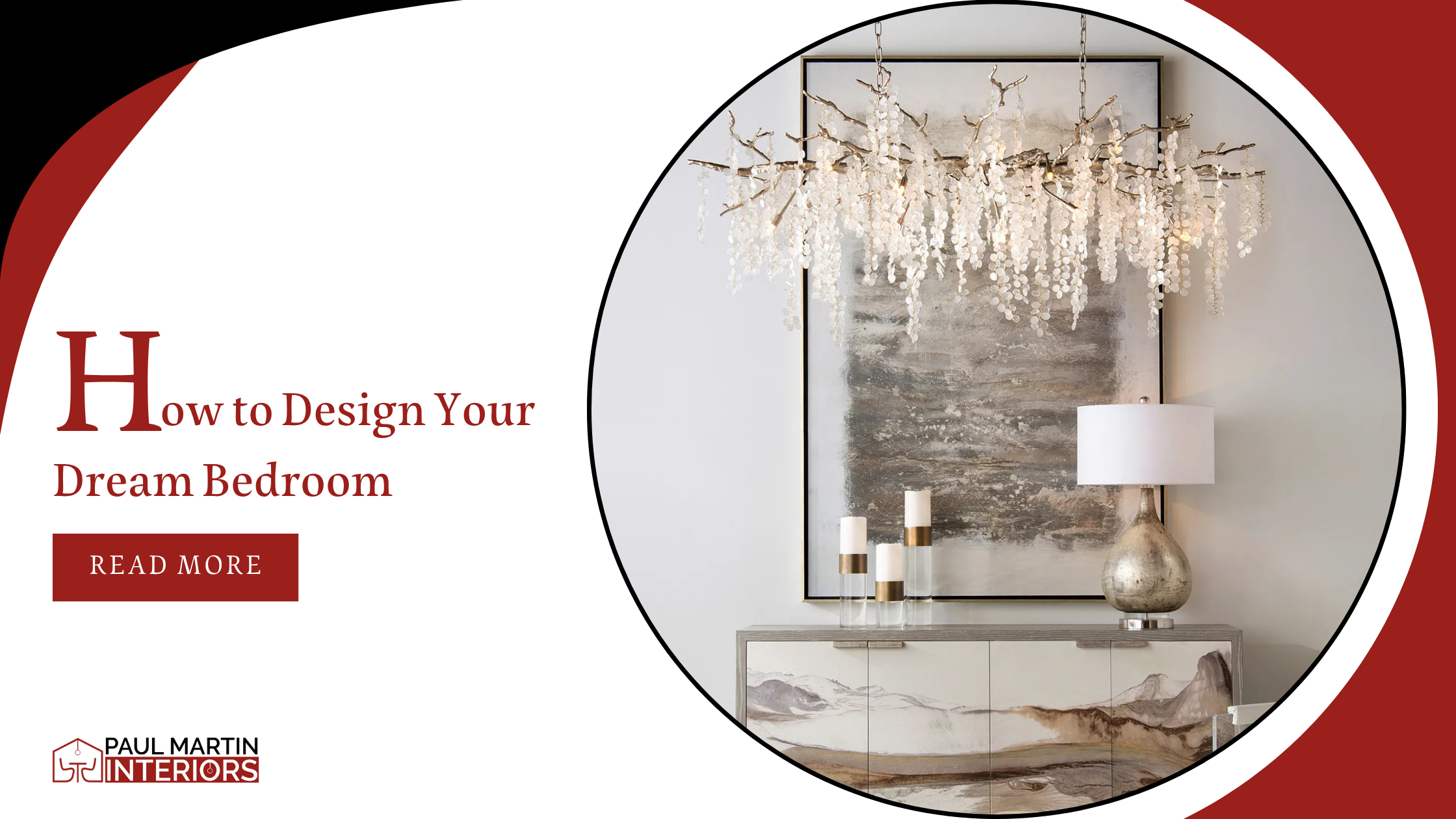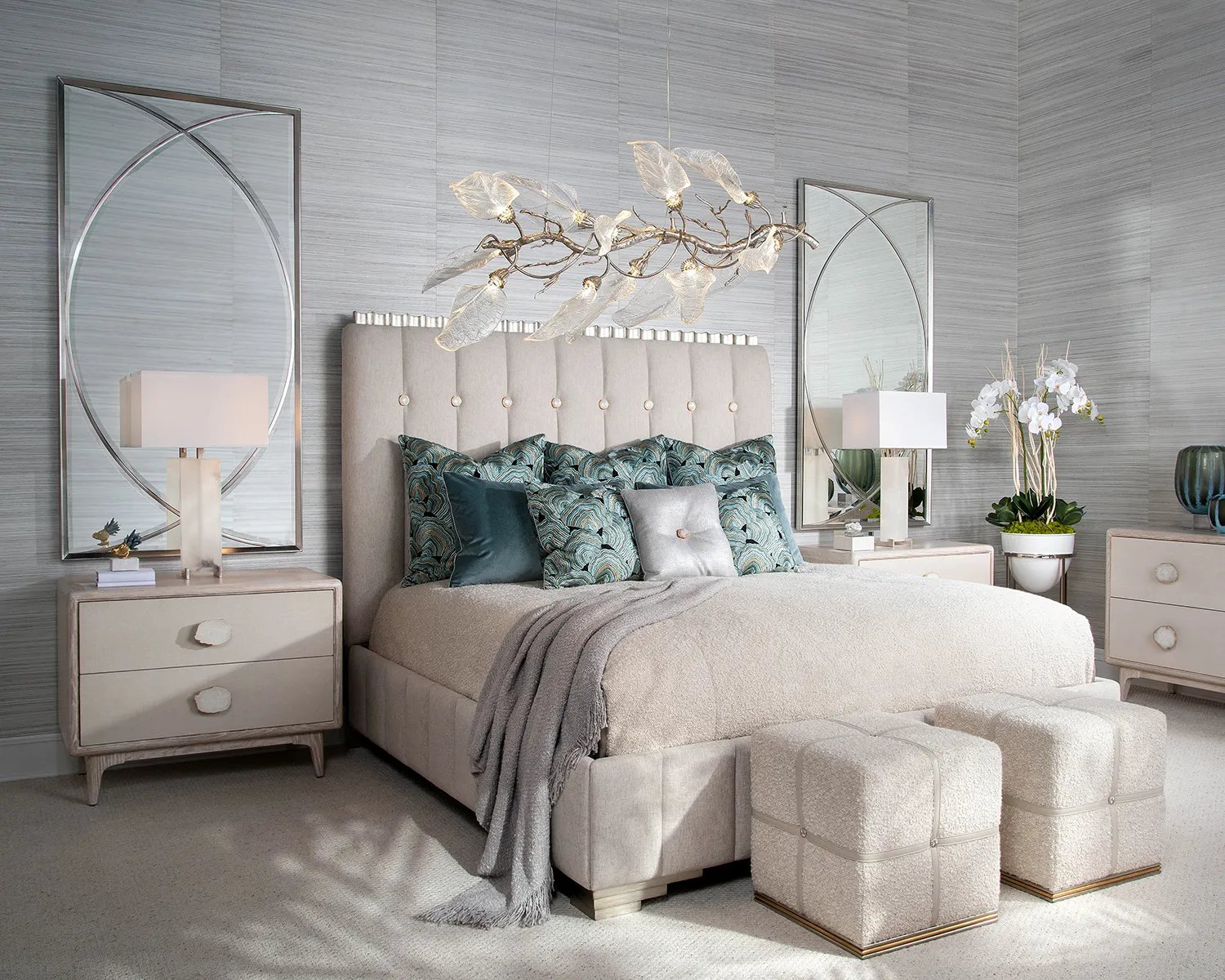- (678) 947 - 4899
- Mon - Sat: 10 AM - 5 PM
How to Design Your Dream Bedroom

- Design choices shape how your bedroom looks, feels, and supports your daily life.
- Each element—colors, fabrics, lighting, and furniture—works together to create a complete space.
- A designer helps turn your ideas into a bedroom that feels personal, stylish, and functional.
A bedroom isn’t just where you sleep. It’s where your day begins and ends—a private retreat that reflects your personality and offers comfort without compromise. If you’ve ever looked around and thought your bedroom feels unfinished, disconnected, or just uninspiring, it might be time for a fresh start.
This guide walks you through how to build your dream bedroom design from the ground up, using furniture, fabrics, rugs, wallpaper, lighting, and accessories that all work together to create a room that looks beautiful and feels like you.
Whether your style is clean and modern or rich and traditional, the right combination of design elements will make your bedroom your favorite place in the house.
Let’s break it down piece by piece.
Why Your Bedroom Design Matters
The way your bedroom looks and feels can affect everything from your sleep quality to your mood, focus, and even your energy levels. When your surroundings are calm, inviting, and thoughtfully arranged, it becomes easier to wind down at night and wake up refreshed.
A well-designed bedroom creates a sense of order. Visual clutter, harsh lighting, or mismatched furniture can lead to mental clutter and restlessness. On the other hand, a room with the right textures, lighting, and layout helps you feel more grounded and in control. This matters even more in today’s fast-paced world, where your bedroom might be one of the few spaces you can truly call your own.
Design choices, like choosing breathable bedding, layering soft lighting, or picking the right rug underfoot, aren’t just aesthetic. They influence how you experience comfort, how well you relax, and how fully you disconnect from the stress of the day.
Be it modern minimalism or classic coziness, your bedroom should reflect you and support how you live. That’s why bedroom interior design, when done right, isn’t a luxury—it’s a lifestyle upgrade you feel every single day.
Choosing the Right Color Palette
The first thing most people notice when they walk into a room is the color, not the furniture, not the curtains. Just the way the room feels because of the tone of the walls, ceiling, and textiles.
When designing a bedroom, stick to colors that support the atmosphere you want. Soft neutrals, warm grays, gentle greens, or calming blues work well if you’re after a quiet, relaxing vibe. If you love drama or a bold personality, deeper jewel tones like navy, emerald, or charcoal can bring that richness without overwhelming the room.
You don’t have to commit to all the walls being one shade. A painted accent wall or wallpaper feature can add visual interest while keeping things cohesive.
Tip: Pick three core tones. One for walls, one for large pieces like bedding or rugs, and one accent that ties everything together.
Selecting Luxurious Bedding
You can’t have a luxury bedroom interior design without giving real thought to the bed itself. More than anything else in the room, your bed sets the tone and comfort level.
Start with quality sheets. Look for breathable, natural fibers like Egyptian cotton or bamboo blends. Then move to the comforter or duvet—this is where you can play with texture and weight. Quilted? Lightweight linen? Something plush and cloud-like? Layering adds comfort and visual dimension.
Don’t forget the pillows. Use two or three types: supportive ones for sleep, soft ones for lounging, and a few decorative pillows to complete the look.
To finish this off, add a throw or blanket at the end of the bed. Beyond just looks, it adds an element of coziness that makes your space feel finished.
Incorporating Layers of Fabric and Texture
Once you’ve chosen bedding, you can build a story around it with fabrics. Think upholstered headboards, soft drapery, velvet benches, textured rugs, and plush accent chairs. This is how you move from a bedroom that feels plain to one that feels warm and personal.
If everything in the room is flat or sleek, it’ll look cold. Mix a nubby linen with a buttery leather, or a crisp cotton with a velvet pillow, and suddenly the space feels designed. Not too perfect, not too staged—just right.
Upholstered elements like headboards or window seats are great spots for showcasing custom fabrics. They act as quiet statements that say, “This room was made for someone specific.”
Bedroom Furniture That Balances Style and Function
Furniture decisions are a big part of your dream bedroom design, and it’s not just about the bed frame. Nightstands, dressers, benches, side tables, and even reading chairs can all add up.
Think about how you use the space. Do you need storage? Space to read? Room for a TV or vanity? Once you know how the room needs to function, you can choose pieces that support that lifestyle without sacrificing style.
When mixing furniture, avoid the “bedroom set” look. A pair of matching nightstands is fine, but contrast them with a dresser in a different tone or texture. Add a bench at the foot of the bed in a soft, curved shape if your other furniture is boxy. Balance is key.
And when it comes to scale, go big. Tiny pieces in a large room make everything feel off. Trust the space and fill it thoughtfully.
Statement Lighting for Mood and Style

Lighting in the bedroom is about more than just visibility, it sets the mood. You need a mix of overhead lights, task lighting, and ambient options. Start with a stylish overhead fixture. A chandelier or pendant light adds drama and can become a true focal point. From there, bring in bedside lamps or wall sconces for reading and softer nighttime lighting. If you’re using table lamps, choose ones with substantial bases so they don’t look lost next to your bed.
Want a soft glow in the evenings? Try layered lighting like dimmable overhead lights, warm-toned bulbs, and even under-bed or behind-the-headboard strip lights. This layering lets you switch between functional and cozy depending on the time of day.
While lighting is often overlooked, it does a lot of heavy lifting in a well-designed bedroom.
Using Rugs to Define the Space
Rugs help anchor the space and add a layer of softness underfoot—a welcome touch when you step out of bed each morning.
Size matters here. One of the most common mistakes is choosing a rug that’s too small. For a queen or king bed, you want the rug to extend at least 18–24 inches on each side. That way, it frames the bed and adds a finished look to the floor.
In terms of material, wool is a popular choice for bedrooms—soft, durable, and naturally warm. For added personality, layer a vintage runner over a jute base, or a patterned rug under neutral furniture. It doesn’t have to match everything, so focus on just playing with your palette.
If your floors are carpeted, a rug can still add definition and color. It’s a way to zone the space and draw the eye where you want it.
Adding Wallpaper for a Personal Touch
Wallpaper is back, and it’s here to stay. If you’re working toward a custom bedroom design idea, wallpaper gives you endless options to express your style. From subtle textures to bold murals, it offers something paint just can’t replicate.
Not ready to commit to a whole room? Try a single accent wall behind the bed. It acts like art, especially if your furniture and accessories are more neutral. Patterns like florals, grasscloths, abstract lines, or geometric shapes all work in a bedroom—it just depends on the feeling you’re going for. Large-scale patterns make a space feel more dramatic, while small-scale ones tend to feel softer and more intimate.
Pair wallpaper with solid bedding and fabrics for balance, or repeat small colors from the wallpaper elsewhere in the room (like your pillows or drapes) to pull it all together.
Window Treatments and Drapery That Elevate the Room
Drapery often comes last in the design process, but it makes a huge impact. In a luxury bedroom interior design, it’s never an afterthought. Start with a function. Do you want blackout panels for sleep, or sheer drapery for diffused light? Sometimes both, layered together, is the best approach.
Then move to style. Floor-to-ceiling drapes in a heavy linen or silk blend can add softness and dimension to the room. They also make ceilings feel taller and the space more grounded. Choose a color that either blends with the walls or contrasts subtly—think soft gray on cream walls or navy against pale beige.
Custom drapery lets you control every detail, from fabric to trim to lining, and gives your bedroom that tailored look you just can’t get with store-bought panels.
Thoughtful Accessories and Finishing Touches
Once the main pieces are in place, it’s time to make the room feel personal. Add a large-scale piece of art over the bed or dresser. Layer books, candles, and trays on your nightstands. Use baskets or sculptural objects to fill empty corners or shelves.
Mirrors are a smart design tool, too—they reflect light, add visual space, and act as functional art. Choose one with a bold frame to make a quiet statement. And don’t forget your bedroom’s signature scent. A favorite candle, oil diffuser, or fresh flowers can instantly shift the mood of the room from average to inviting.
Accessories are where your personality comes through. Don’t overthink it and just include the pieces you love looking at every day.
How to Work with a Designer for a Custom Bedroom Design
If you want your bedroom to truly reflect your lifestyle, taste, and comfort preferences, working with an interior designer can make all the difference. At Paul Martin Interiors, LLC, the goal is simple: to turn your ideas into a space that feels just right, down to the last detail.
The process starts with a conversation. You’ll discuss how you use your bedroom, your style preferences, what’s working, and what’s not. From there, the designer takes care of the details you may not have considered, like space planning for flow and functionality, or selecting the right fabrics for both comfort and durability.
Unlike DIY design, where you’re juggling choices and hoping they work together, a designer brings clarity and cohesion. Whether it’s sourcing the perfect bedding, choosing custom window treatments and drapery, or curating textures and finishes that complement each other, everything is tailored to your space and your lifestyle.
Working with a designer is all about creating a bedroom that works for you, feels like home, and stands the test of time.
Ready to design the bedroom you’ve always wanted? Contact us today at Paul Martin Interiors, LLC, and let’s bring your vision to life!
